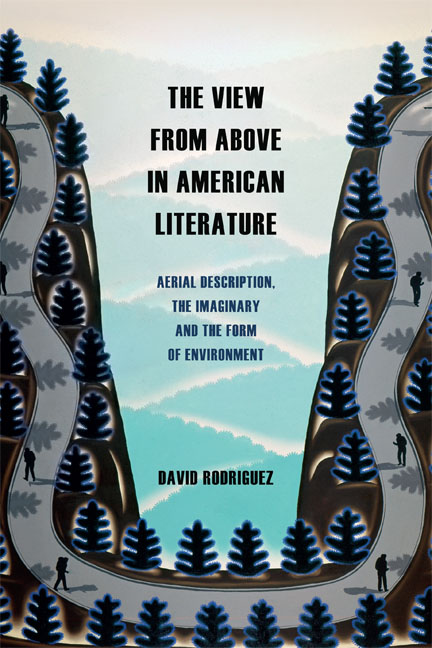 The View from Above in American Literature
The View from Above in American Literature Book contents
- Frontmatter
- Contents
- List of Figures
- Acknowledgements
- Introduction: Flights Without Wings
- 1 Foundations for the View from Above in Literary Fiction: Description, Form and Indeterminacy
- 2 Extent, Built Form and Willa Cather’s Landscapes
- 3 Verticality and Empty Thematics in Paul Bowles’s Novels
- 4 ‘Only Scenery’: Scale, Whole-Earth Images and Don DeLillo’s ‘Human Moments in World War III’
- Conclusion: On Drone and Satellite Images
- Bibliography
- Index
1 - Foundations for the View from Above in Literary Fiction: Description, Form and Indeterminacy
Published online by Cambridge University Press: 06 March 2025
- Frontmatter
- Contents
- List of Figures
- Acknowledgements
- Introduction: Flights Without Wings
- 1 Foundations for the View from Above in Literary Fiction: Description, Form and Indeterminacy
- 2 Extent, Built Form and Willa Cather’s Landscapes
- 3 Verticality and Empty Thematics in Paul Bowles’s Novels
- 4 ‘Only Scenery’: Scale, Whole-Earth Images and Don DeLillo’s ‘Human Moments in World War III’
- Conclusion: On Drone and Satellite Images
- Bibliography
- Index
Summary
The view from above has a strange, unavoidable attraction for pinpointing the essence of epistemological and ontological relationships between humans and the world. There are three terms in the phenomenology of the view from above: the subject that sees, the object that is seen and the context that structures this encounter. It is easy to imagine the subject as human, though, materially, it is often an animal or a machine. The object can be any kind of ‘view’, from a natural feature to a human settlement. The context of this experience can be a meditation during a mountain hike, a terrified stare in flight, a bored glance from a tall building or a camera pointed vertically down at a shoreline, obliquely across a desert or moving automatically to track a target. In daily experience, the object is primary; I look down from the top of this peak and wonder at how the trees are reflected off a lake to show the scene twice. But in analysis, the context or the subject is considered primary: who sees, why and how?
In this book, I will maintain the object as the main term in my study of the view from above. But there is a twist, because I am considering the objectivity of fictional descriptions of the view from above. To do so, I am constructing a different third term: the form of environment mediated by literary images in description.
In literary and cultural criticism, the context is almost always taken for granted to be as real as the first two terms, and it is usually considered to be the ideology of dominant, globalising reflection. Only recently have critics begun to challenge this third term by developing other, nonanthropogenic definitions: Caren Kaplan in Aerial Aftermaths considers the materiality of war and Heather Houser in Infowhelm thinks about climate change. Unlike Patrick Ellis's valuable recent book Aeroscopics that details the forgotten archival responses to the popular amusements of pre-aeroplane aerial images and experiences such as balloon rides and panoramic paintings, I focus on the ways that the reading experience and the literary work of art as an object affords its own, specifically imaginary structure of the view from above and the environment implaced in it.
Information
- Type
- Chapter
- Information
- The View from Above in American LiteratureAerial Description, the Imaginary and the Form of Environment, pp. 16 - 49Publisher: Edinburgh University PressPrint publication year: 2024